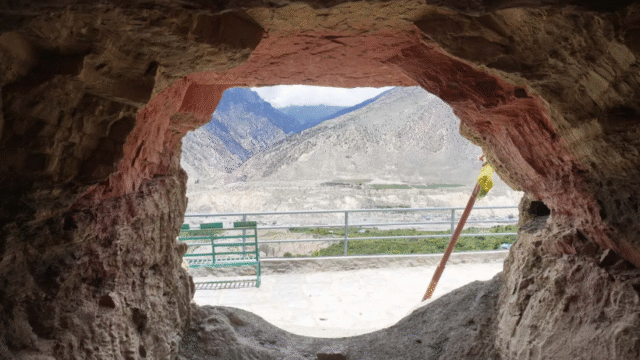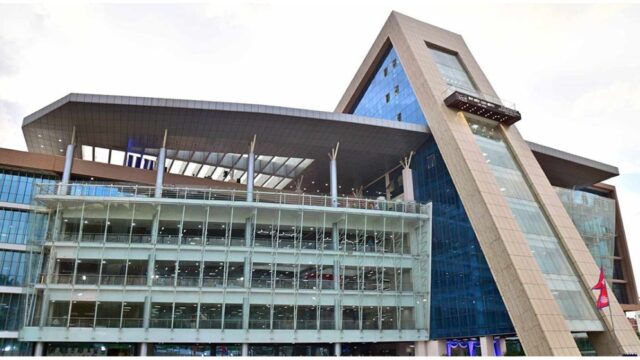To develop religious tourism, Jaimini Municipality in Baglung has begun actively promoting the once-overlooked site of Hattidhunga, a unique rock formation now gaining popularity among pilgrims and tourists alike. Once nearly forgotten, Hattidhunga has emerged over the last few years as a site of increasing spiritual and touristic significance.
A Decade Ago, Hattidhunga Was Unknown
Located in Ward No. 9 of Jaimini Municipality, in Paiyunthanthap, the Hattidhunga (literally “Elephant Rock”) site remained largely unknown until recent years. According to local elders, the massive rock was first discovered around B.S. 2006 (circa 1949 AD). The formation features a protrusion resembling an elephant’s trunk, which inspired its name.
Though the locals began worshipping it as a form of Lord Ganesh from B.S. 2012 onwards, the site received minimal external attention. Pilgrims from outside the village rarely visited. However, as word spread about the site’s uniqueness and religious association, more visitors from neighboring towns began to arrive, sparking a new era of interest in the sacred location.
Municipality Invests in Infrastructure and Development
Recognizing its growing popularity, Jaimini Municipality has prioritized the development of physical infrastructure to make Hattidhunga more accessible and appealing. In the current fiscal year, a budget of NPR 10 million was allocated through the Federal Ministry of Urban Development for infrastructure enhancement.
According to Deputy Mayor Harihar Sharma, NPR 5 million was spent to construct a road linking Barikhet to Hattidhunga, while another NPR 5 million was utilized to build a temple, a playground, and resting shelters (sattal) for visitors. In addition, the municipality has previously completed the installation of drinking water facilities and public toilets in the area to improve the overall tourist experience.
Religious Significance Boosts Visitor Numbers
Deputy Mayor Sharma emphasized that Hattidhunga is now one of the primary tourist attractions in Jaimini, with both religious and recreational appeal. “We are working to develop it as a religious and tourism destination,” Sharma stated. “The number of visitors is growing steadily, especially during key religious events. So far, various government entities have invested more than NPR 14 million in the site’s development, and we continue to allocate funds for its promotion.”
A Shiva temple has also been constructed at the site, complementing the existing Siddhivinayak Ganesh worship area and enriching the spiritual atmosphere of the location. The move is expected to attract more pilgrims year-round, especially during Shivaratri, which has already become a major annual event for the area.
Local Belief Fuels Pilgrimage Growth
Local resident Tul Bahadur Thapa noted that the number of religious visitors has increased due to the belief that prayers offered at Hattidhunga can fulfill devotees’ wishes. “There’s a growing belief in the spiritual power of the place, especially among people from neighboring areas such as Bareng, Baglung, and Gulmi,” Thapa said. “Earlier, only local villagers came to worship here, but now, pilgrims are coming from farther away. The area is livelier than ever.”
Thapa also emphasized the need for further upgrades to the access road, noting that the current trail still lacks the standard needed to handle the increasing number of visitors.
Ongoing Commitment to Sustainable Tourism
Hattidhunga’s transformation from a little-known site to a thriving spiritual destination is an example of how community belief, combined with government investment, can revitalize rural tourism. The municipality’s efforts reflect a broader push across Nepal to develop religious and rural tourism through infrastructure, awareness campaigns, and community engagement.
The municipal government has continuously budgeted for development in the area and has committed to further improvements in the coming years. These plans include the addition of more visitor amenities, further road expansion, and cultural programming during major festivals.
Conclusion: Hattidhunga’s Rising Profile in Baglung’s Tourism Landscape
The rapid rise in popularity of Hattidhunga showcases the growing importance of religious tourism in Nepal’s local development strategies. What began as a locally revered rock formation has now turned into a spiritual landmark drawing hundreds of devotees and tourists. The blend of natural formation, mythological association, and active development has made it a point of pride for the people of Jaimini and surrounding areas.
With continued support from the local and federal governments, along with growing recognition from visitors, Hattidhunga has the potential to become a regional pilgrimage hub and a highlight of Baglung’s expanding tourism offerings. As infrastructure improves and more stories emerge about its religious significance, Hattidhunga could soon be recognized as one of Nepal’s treasured spiritual destinations.






